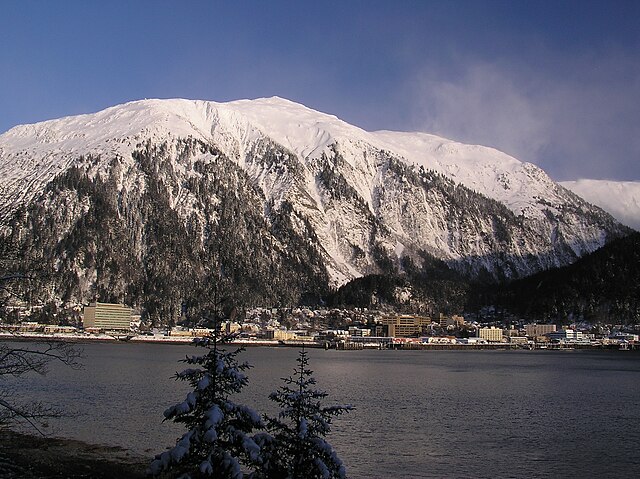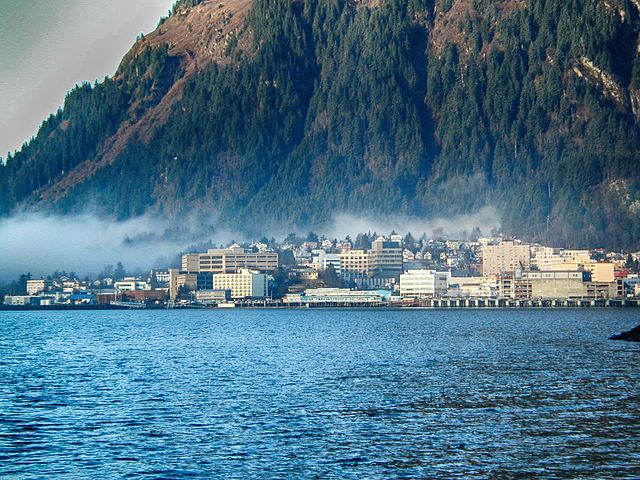Ever wondered what it’s like to experience the weather in Juneau, Alaska? Nestled between towering mountains and the Gastineau Channel, Juneau’s climate is as dramatic as its scenery. From misty rainforests to occasional sunny days, the weather here tells a story of nature’s unpredictability. Whether you’re planning a cruise, a hiking adventure, or just curious about life in Alaska’s capital, understanding Juneau’s weather is key to making the most of your time. Let’s dive into the seasons, temperatures, and quirky weather patterns that make Juneau so unique!
Why Juneau’s Weather Is So Unique
Juneau’s weather is like a moody artist—full of surprises and never quite what you expect. Its location in Southeast Alaska, surrounded by mountains and ocean, creates a microclimate that’s distinct even from other parts of the state. The Tongass National Forest, one of the largest temperate rainforests in the world, blankets the region, soaking up moisture from the Pacific Ocean. This combo of geography and ocean currents keeps Juneau’s weather cool, wet, and wildly variable. Think of it as nature’s way of keeping you on your toes!
The Role of Geography in Shaping Juneau’s Climate

Juneau sits in a coastal pocket, hemmed in by the Coast Mountains and the sea. These mountains act like a giant sponge, catching clouds rolling in from the Pacific and squeezing out rain—lots of it. The city’s position also means it’s shielded from some of Alaska’s harsher interior weather, like bone-chilling arctic blasts. Instead, you get a milder, maritime climate that feels more like Seattle than Fairbanks. But don’t let “milder” fool you; Juneau’s weather can still throw curveballs, like sudden fog or gusty winds.
How Ocean Currents Influence Temperatures
The Alaska Current, a warm ocean flow from the Pacific, plays a big role in keeping Juneau’s temperatures from plummeting too far. It’s like a cozy blanket for the coast, ensuring winters rarely dip below zero and summers stay refreshingly cool. This current also pumps moisture into the air, which means you’re more likely to see drizzle than snow, even in January. It’s a delicate dance between land, sea, and sky that gives Juneau its signature weather vibe.
Juneau’s Weather by Season
Juneau’s weather changes with the seasons, but one thing stays constant: you’ll need a rain jacket! Each season has its own personality, from the long, light days of summer to the dark, cozy winters. Let’s break it down so you know what to expect year-round.
Spring: A Time of Transition
Spring in Juneau, from March to May, is like waking up from a long nap. Temperatures creep up from the low 30s to the mid-50s Fahrenheit, and daylight stretches longer each day. But don’t pack away your umbrella just yet—rain is still a frequent guest, with about 15 rainy days per month. Snow starts to melt in the lower elevations, but the mountains stay capped in white. It’s a great time for early hikes, as long as you’re ready for muddy trails and unpredictable showers.
What to Wear in Spring
Layers are your best friend in Juneau’s spring. Start with a moisture-wicking base layer, add a fleece or sweater, and top it with a waterproof jacket. Waterproof boots are a must for splashing through puddles or tackling snowy trails. Think of your outfit like a lasagna—lots of layers you can peel off if the sun makes a rare appearance!
Summer: Long Days and Mild Weather
Summer, from June to August, is Juneau’s golden season. With up to 18 hours of daylight, it’s perfect for exploring glaciers, whale watching, or hiking in the Tongass. Highs range from 55°F to 65°F, though occasional warm spells can hit the low 70s. Rain is still common, with June seeing about 46% chance of precipitation daily. But when the sun breaks through, it’s like the whole city sparkles. Just don’t expect tropical heat—Juneau’s summer is more like a crisp autumn day elsewhere.
Summer Activities and Weather Tips
Summer weather opens up endless possibilities in Juneau. Hit the Mendenhall Glacier for a chilly but stunning hike, or take a boat tour to spot humpback whales. Always check the forecast before heading out, as fog can roll in fast. Pack sunscreen (yes, even in Alaska!) and a light raincoat. It’s like preparing for a picnic where the weather might decide to gatecrash.
Fall: A Colorful, Wet Transition
Fall in Juneau, from September to November, is a painter’s dream. The forests turn gold and red, but the rain picks up, with October being the wettest month. Temperatures drop from the 50s to the 30s, and snow starts dusting the mountains. It’s a quieter time for tourists, perfect for cozy coffee shop visits or scenic drives. Just be ready for windier days and shorter daylight hours.
Fall calls for sturdy rain gear and warm layers. A good pair of waterproof pants can save the day on soggy hikes. Locals swear by Xtratuf boots, Alaska’s unofficial footwear, for keeping feet dry. Think of fall in Juneau like a rainy camping trip—you’ll love the beauty, but you’ve got to embrace the damp.
Winter: Dark, Cool, and Surprisingly Mild
Winter in Juneau, from December to February, is more about drizzle than blizzards. Highs hover in the 30s, with lows in the 20s, and snow is less common in the city than in Alaska’s interior. But with only 6 hours of daylight in December, it feels like the sun’s on a coffee break. The mountains get plenty of snow, making nearby ski areas like Eaglecrest a local favorite. Winter’s charm lies in its quiet, with aurora sightings possible on clear nights.
Winter Weather Preparedness
Winter in Juneau demands warm, waterproof clothing. A puffy jacket, thermal base layers, and a knit hat will keep you cozy. Ice grippers for your boots are handy for slick sidewalks. It’s like gearing up for a polar expedition, but with better coffee shops to warm up in afterward.
Average Temperature and Precipitation in Juneau

Juneau’s weather is defined by cool temperatures and plenty of rain. Annual precipitation averages 62 inches, with some years seeing up to 90 inches. Snowfall in the city is modest, about 80 inches annually, but higher elevations get buried. Here’s a quick look at the averages:
- January: High 33°F, Low 24°F, 5.6 inches rain/snow
- April: High 48°F, Low 34°F, 3.7 inches rain
- July: High 64°F, Low 50°F, 4.7 inches rain
- October: High 47°F, Low 38°F, 8.3 inches rain
These numbers are just a starting point—Juneau’s weather loves to keep you guessing!
Rare Weather Events in Juneau
Juneau’s weather isn’t just rain and fog; it can throw some wild surprises. In June 2025, a rare severe thunderstorm hit the city, with 60 mph winds strong enough to push a cruise ship from its dock. Thunderstorms are super rare here, happening once every couple of years. Heat advisories, like the one issued in Fairbanks in 2025, are also uncommon but can spill into Southeast Alaska during unusual warm spells. It’s like Mother Nature decided to shake things up!
Thunderstorms and Wind Gusts
Thunderstorms in Juneau are like spotting a unicorn. The cool, stable air usually keeps them at bay, but when they hit, they bring gusty winds and dramatic skies. The June 2025 storm was a historic event, marking the city’s first-ever Severe Thunderstorm Warning. If you’re visiting, don’t worry too much—these are rare, but always stay alert for sudden wind shifts near the water.
Heat Waves and Warm Spells
Heat waves in Juneau? It sounds like a joke, but they do happen. In June 2025, forecasts predicted highs in the 70s, even touching 80°F in some spots. These warm spells are short-lived, often followed by a return to cool, rainy norms. It’s like Juneau’s weather is teasing you with a taste of summer before pulling the plug.
How to Prepare for Juneau’s Weather
Juneau’s weather is part of its charm, but it demands respect. Whether you’re a tourist or a new resident, preparation is key. Always check the forecast before heading out, especially for outdoor activities like hiking or boating. The National Weather Service’s Juneau office is a great resource for real-time updates. And don’t skimp on gear—invest in quality rainwear and sturdy shoes. It’s like packing for an adventure where the weather is the main character.
Essential Gear for Juneau’s Climate
Your Juneau packing list should include a waterproof jacket, breathable layers, and waterproof footwear. A compact umbrella is handy for city strolls, but it might not survive gusty winds. For hikers, trekking poles and a backpack cover are lifesavers. Think of your gear like a superhero suit—ready to tackle whatever the weather throws at you.
Checking Local Weather Forecasts
Local forecasts are your best bet for staying ahead of Juneau’s weather. Websites like Weather Underground and The Weather Channel offer detailed 10-day forecasts, while the NWS provides alerts for rare events like thunderstorms. Apps like AccuWeather are great for hourly updates. It’s like having a crystal ball for Juneau’s ever-changing skies.
Tips for Enjoying Juneau’s Weather

Juneau’s weather might seem daunting, but it’s all about perspective. Embrace the rain as part of the adventure—it’s what makes the forests so lush and the waterfalls so spectacular. Plan indoor activities, like visiting the Alaska State Museum, for rainy days. And when the sun shines, drop everything and get outside. It’s like catching a rare Pokémon—you’ve got to seize the moment!
Indoor Activities for Rainy Days
Rainy days in Juneau are perfect for cozying up in a café or exploring indoor attractions. Check out the Juneau-Douglas City Museum for a dose of local history, or sip craft beer at a brewery like Alaskan Brewing Co. It’s like finding a warm hug on a soggy day.
Outdoor Adventures When the Sun Shines
When the sun comes out, Juneau transforms into a playground. Hike the Perseverance Trail for gold rush history, or kayak in Auke Bay for a chance to spot seals. Sunny days are rare, so treat them like a VIP pass to Alaska’s beauty.
Conclusion: Embracing Juneau’s Weather
Juneau’s weather is as much a part of the city as its glaciers and mountains. It’s wild, wet, and wonderfully unpredictable, shaping everything from daily life to epic adventures. By understanding its patterns and packing smart, you can turn any day in Juneau into a memorable experience. So grab your raincoat, lace up your boots, and dive into the magic of Alaska’s capital—rain or shine, it’s a journey worth taking!
Frequently Asked Questions About Juneau, Alaska Weather
1. What is the best time of year to visit Juneau for good weather?
Summer (June to August) offers the mildest temperatures and longest daylight hours, but expect rain. May and September are less crowded with decent weather, though cooler and wetter.
2. Does it rain every day in Juneau?
Not every day, but rain is common, especially in fall and winter. Juneau averages 150–200 rainy days a year, so pack waterproof gear and embrace the drizzle!
3. How cold does it get in Juneau during winter?
Winter highs are typically in the 30s°F, with lows in the 20s. It’s milder than interior Alaska, but wet snow and icy patches can make it feel chillier.
4. Are thunderstorms common in Juneau?
No, thunderstorms are rare, occurring about once every two years. The June 2025 storm was a historic outlier, so don’t expect lightning on your visit.
5. What should I pack for a trip to Juneau?
Pack layers, a waterproof jacket, sturdy shoes or boots, and a hat. Xtratuf boots are popular locally. Bring sunscreen and sunglasses for sunny summer days.

